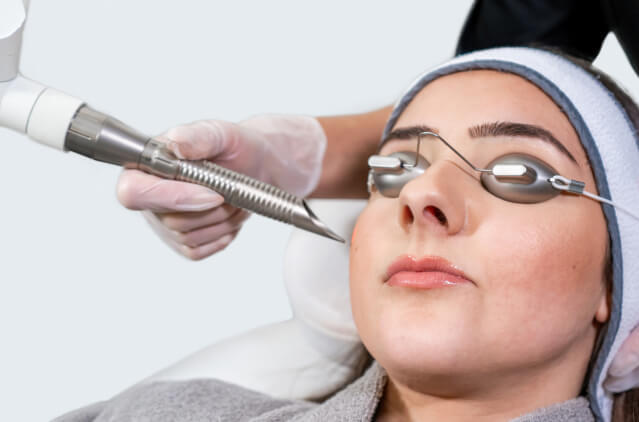
Nowadays, lasers are used for many procedures. Laser means “Light Amplification by Stimulated emission of Radiation”. Laser treatment is used for acne, age spots, unwanted hair on the body, unwanted tattoos, broken blood vessels, etc. Lasers emit high-intensity light with a single wavelength (with one colour) and target a specific tissue known as chromatophore (part of the skin tissue that gives it the colour) in the skin. The chromatophores absorb the rays and get destroyed. This causes the formation of new cells by stimulating collagen production, replacing the damaged cells, resulting in a clear, smooth and supple skin. Q-switch laser, previously a gold standard treatment for tattoo removal, is an important tool in cosmetic dermatology.
What does Q-switch Laser Treat?
The Q-switch laser is non-ablative and can heat the deeper layers of the skin without damaging the surrounding tissues. This also prevents the development of scars. Q-switch laser is used for:
- Skin rejuvenation like treating uneven skin tone, skin resurfacing, etc.
- Tattoo removal
- Wrinkle removal
- Lightening or removing skin pigmentation-
- Treating acne scars
- Melasma
- Skin and Vascular lesions like melasma, age spots, spider veins, etc.
- Toning your skin of the face, neck, chest and back.
How Do Q-switch Lasers Work?
Q-switch lasers are used for different procedures based on their wavelength. Q-switch lasers with longer wavelengths (1064 nm and 532 nm) are preferred to treat hyperpigmentation (age spots, tattoos, freckles, sun spots, birth are preferred marks, etc.) issues in the skin as they penetrate deep into the skin. They target the melanin present in the superficial layer of the skin. Laser light on the pigmented areas converts into heat and destroys the pigment cells, sparing the surrounding tissues. Q-switch lasers with 1064 nm and 532 nm are used in these conditions as lasers with longer wavelengths penetrate deeper into the skin. For freckles, Q-switch lasers with shorter wavelengths are used (532 nm) as freckles are present in the top layer of the dermis.
Different brands of Q-switch lasers exist in the market – Q-switched Nd: YAG lasers, Q-switched Ruby lasers, Q-switched Alexandrite lasers and Picosecond Alexandrite lasers.
How Are Q- switch Lasers Different From Regular Lasers?
Q-switch lasers deliver the energy (light) in very short pulses of the same wavelength. These very short pulses of energy disrupt the pigment-containing cells leading to their destruction. This property of Q-switch lasers makes them beneficial in treating hyperpigmentation issues and tattoo removal. Regular lasers, on the other hand, emit energy in one pulse (one continuous light beam) to the targetted area, commonly water, pigment cells and blood vessels. The advantage of using a Q-switched laser is that as the energy is emitted in bursts, it allows time for precision and minimises the heat built up, thereby reducing damage to the tissue present beneath the skin.
Q-Switch Laser Treatment
This non-ablative treatment will take around 40 to 45 minutes per session. Your surgeon will inform you on the number of sessions required depending on your condition.
What to Expect Before Your Laser Treatment
- Your doctor will record your detailed medical and family history for any debilitating diseases (like diabetes, high blood pressure). You should inform your dermatologist about any allergies that you have or supplements that you are on.
- Your dermatologist will ask questions about your daily skin routine and conduct a thorough physical examination.
- Your dermatologist will discuss your option and recommend a course (number of sessions required) for the treatment.
What to Expect On the Day of The Treatment?
Your dermatologist will clean the treatment area thoroughly and apply a local anaesthetic cream to numb the area.
A thin layer of carbon cream is applied, which helps break down pigment cells in the skin by the laser beam.
The laser beam of a particular wavelength (relative to your condition) is applied in bursts on the skin- this will cause the heating up of the carbon and stimulates its binding to the skin.
Finally, the laser will break the liquid carbon into small particles removed by the smoke evaporator connected to the laser. The debris along with impurities in the carbon particles, are removed by the evaporator.
Once the session is completed, cotton balls dipped in saline is used to clean the skin.
How is The Recovery Period After the Session?
There is no downtime associated with Q-switch Laser, and you can resume going to work the same day. In some cases , the skin may remain grey or white for a few minutes. In individuals with sensitive skin, redness may persists for a few days. You should not be worried as it will subside on its own. Within 7 to 10 days, the skin is healed. The time between sessions will depend on your condition and skin type. Some of the precautions to be taken after the session:
- Do not go out in the sun
- Do not soak the treated area in water
- Do not touch, itch or prick at the treated area
- Apply an antibiotic cream over the treated area and keep it covered for 7 to 10 days.
Q-switch laser treatment for acne, wrinkles and many more are performed using state-of-the-art technology at Kosmoderma Skin, Hair, and Body Clinic Consult now!



